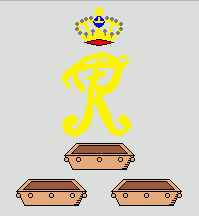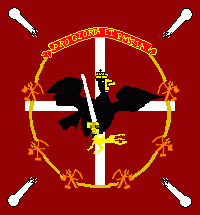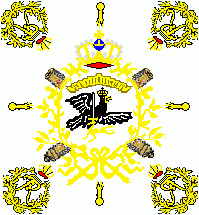 Image by Klaus-Michael Schneider
Image by Klaus-Michael Schneider
Last modified: 2012-09-05 by pete loeser
Keywords: prussia | military | infantry | dragoons | eagle (black) | wreath (yellow) | crown: royal | cross: maltese (red) | pennant |
Links: FOTW homepage |
search |
disclaimer and copyright |
write us |
mirrors
On this page:
See also:
Following the two Silesian wars of the 1740s, Frederick the Great made a series of changes in the Prussian army's doctrine, focusing on speed and offense on the battlefield. He encouraged his military leaders to develop tactics for lighter and faster cavalry; units like the Hussars
(light cavalry) and Dragoons (originally mounted infantry) and they were made a more integral part of the army, in preference to the heavier Cuirassiers. Rather than using frontal attacks, the new Prussian doctrine tried to apply oblique tactics, by which the army's strongest wing was focused against the enemy's weakest wing or flank. To succeed it required a very disciplined and coordinated army and required bold charges and enveloping operations.
Under this new doctrine artillery was relegated to a close support role for the infantry. Attached to each infantry regiment were light three-pounder guns which theoretically made up for their lack of power with versatility. Kept in reserve were heavier twelve-pounder weapons.
This new concept of a swiftly moving army, required combat engineer
units to support the new doctrine. Their organization was designed for clearing and mending roads, and for the construction of pontoon bridges, all to empower a speedier march of the combat troops.
Ian Sumner, 22 April 2011
 Image by Klaus-Michael Schneider
Image by Klaus-Michael Schneider
It is a red flag with a cypher of Friedrich I in the lower flyend and the upper hoist. In both other corners is a different cypher, "SC" for Sophie Charlotte, who gave her name to the city. In the centre of the flag is the coat-of-arms of Charlottenburg. Sources: [neu39a]; p.61
Klaus-Michael Schneider, 16 January 2011
Sophia Charlotte of Hanover was married to the regent Frederick III of Brandenburg-Prussia, thus she became Electress of Brandenburg in 1688, and when her husband became Frederick I, King in Prussia, she became the first Queen in Prussia in 1701. Their son became King Frederick William I of Prussia, and her brother became King George I of England in 1714. Charlottenburg, named in her honor, remained an independent city to the west of Berlin until 1920, when it became a borough of Greater Berlin (Groß-Berlin).
Based on text from Historical Flags of Our Ancestors, 18 April 2011
 Image by Klaus-Michael Schneider
Image by Klaus-Michael Schneider
The Pontoonier Regiment Colours have a ratio of approximately 19:18. It is light grey flag with three brownish pontoons, ordered one above two in the bottom half, in the upper half is a golden cypher topped by a royal crown. Sources: [neu39a]; p.37
Klaus-Michael Schneider, 16 January 2011
An officer or soldier in charge of bridge equipment or the construction of pontoon bridges is known as a Pontoonier. A Pontonier regiment would use special pontoon wagons to transport pontoons used to quickly build bridges for river crossings.
Text from Historical Flags of Our Ancestors, 18 April 2011
Pontoons, hence pontooniers (with a double o). The wartime establishment of the Prussian bridging train was 53 men, so calling them an "regiment" is rather an exaggeration. The bridging train was attached to the heavy artillery, and consisted of twenty-seven or twenty-eight men in peacetime, and fifty-three in wartime. The pontoons were stored in Berlin, Magdeburg and Neisse. The ponttons were made of thin sheet copper.
Ian Sumner, 20-21 April 2011
 Image by Klaus-Michael Schneider
Image by Klaus-Michael Schneider
This flag has a ratio of approximately 19:18. It is a dark red flag with a white Greek cross in its centre, in each corner is a white flying cannon ball, the cross is surrounded by a golden rope, which is superimposed by 6 golden bundles of tools, each containing a spade, a hammer, an axe and a mattock. The upper part of the rope is superimposed by a red scroll with motto in golden letters. In the centre of the flag is the Prussian eagle (pattern 1740) superimposing the cross. Sources: [neu39a]; p.37
Klaus-Michael Schneider, 17 January 2011
Pioneer units are combat engineers; also known as sappers. The Pioneers' primary job was to assist other Arms in tasks such as construction of field fortifications or military camps. They were also employed during combat to infiltrate and destroy enemy fortifications.
Text from Historical Flags of Our Ancestors website, 18 March 2011
Sappers were men who dug "saps," - i.e. trenches. According to Bennett Cuthbertson's "A system for the compleat interior management and oeconomy of a battalion of infantry" (Dublin, 1768), pioneers "are principally designed for clearing and mending roads, for the convenient and speedy march of a Battalion." Since they were equipped with saws, axes and spades, they would undoubtedly be involved in fortification and seige work, but that was not their primary function.
Ian Sumner, 20 April 2011
The Pioneers were originally organised into a regiment, raised in 1742 and based at Neisse, employed in making and repairing military roads. Frederick thought so little of them that he converted the regiment
into a fusilier regiment in 1758. According to [fie36] the Leibfahne was white, the Regimentsfahne in grey-brown, with painted devices. When the regiment was converted to infantry, it was issued with infantry-style colours.
Ian Sumner, 21 April 2011
 Image by Klaus-Michael Schneider
Image by Klaus-Michael Schneider
Artillery Regiment (1756)
ratio: approx 19:18
colour of sheet: white
colour of scroll: golden
colour of mirror: white
colour of ornaments: golden
additional elements: pair of saltirishly crossed gun barrels, superimposed by the mirror.
Sources: [neu39a]; p.37
Klaus-Michael Schneider, 16 January 2011
The artillery was considered one of the weak points in Frederick the Great's army, because he attached his artillery pieces, usually 3 or 6-pounders, among his infantry so each unit had its own cannon. The weakness was this made it difficult to concentrate all artillery fire in one place on large battlefields. His cannons were transported with the infantry on carriages, wheels and limbers. The wooden parts were all painted light blue while the metal pieces were painted black.
Text from Historical Flags of Our Ancestors, 18 April 2011
Every army, not just the Prussians, had artillery pieces that served with the infantry. Frederick had a battery of eighteen heavy pieces at Rossbach (1757), and by the end of the war a heavy battery was attached to every infantry brigade. Every cannon of every army was transported on a gun carriage with wheels; batteries would undoubtedly have limbers and caissons as part of their TOE.
I would agree, however, that Frederick did not lavish the same amount of care and attention on the artillery as he did with his infantry and cavalry, and it was less impressively organised than those of France or Austria. In the War of the Austrian Succession and the early part of the Seven Years' War, however, the Prussian infantry and cavalry were so much better than their opponents that the differences in the artillery were not apparent.
The Seven Years' War Project website has some good information on the period.
Ian Sumner, 20 April 2011
The artillery was a single battalion in 1740, two battalions in 1741 and three battalions in 1758. In 1762, two regiments, each of three battalions were created; each battalions consisted of five companies.
The following year the two regiments became three, of two battalions each. A fourth regiment was added in 1772. However [fie36] seems to say that there was just one colour for the whole of the Arm.
Ian Sumner, 21 April 2011




